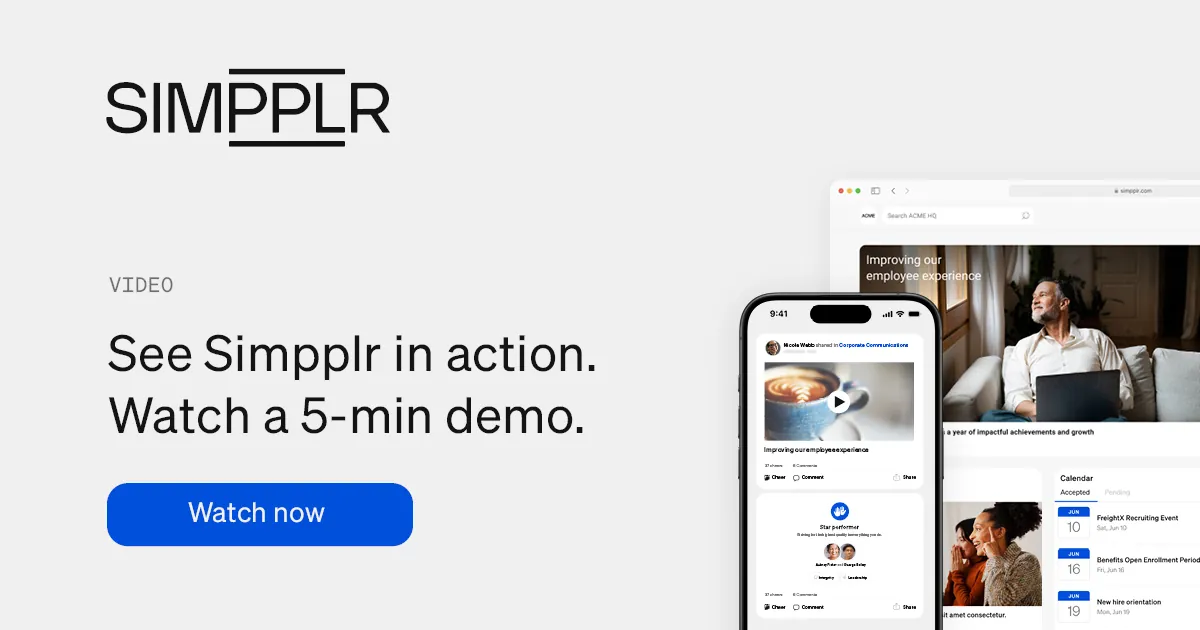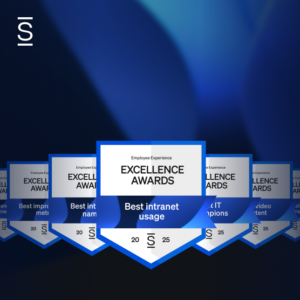This article was originally published on Nov. 25, 2022, and was updated on Jul. 26, 2024.
Why should you conduct an employee experience survey? EX has emerged as a critical factor in shaping a productive, engaged and loyal workforce — and as a driver of organizational outcomes like employee retention and revenue growth. An effective EX survey is a valuable tool for gauging how employees feel about myriad aspects of their work experience so you can take the actions needed to make it better.
When employees have a positive experience at work, they are more satisfied with their jobs, less likely to leave, and perform better overall.
And that’s good for business. Studies show that organizations with a positive employee experience:
- Are 25% more profitable
- Achieve 2x higher customer satisfaction scores (NPS)
- Experience 1.8x revenue growth compared to competitors
- See 12% greater shareholder returns
High employee engagement is a key indicator of positive employee experience. Forbes found that companies with engaged employees outperform those without by up to 202%. And here’s more proof that engaged employees impact the metrics that matter most:
- 59% less turnover among engaged teams
- 21% more productivity
- 147% more earnings per share
That’s what’s at stake. So let’s dive into the nitty-gritty of employee experience surveys so you can better understand and enhance how employees feel about their workplace.
Related: Next in EX — Trends shaping employee experience

What is an employee experience survey?
An employee experience survey is a process used to understand how employees feel about various aspects of their work experiences, including their work environment, relationships with managers and colleagues, sense of belonging within the company culture, tools and resources at their disposal, how their work fits into the bigger picture, overall job satisfaction and more.
When you measure employee experience, you’re essentially looking at your organization through your employees’ eyes.
By collecting this feedback, you can identify trends, pinpoint areas that need improvement, and implement changes to improve the overall employee experience.
Benefits of an employee experience survey
When you deploy employee experience surveys to better understand your workforce in the service of creating a more positive and productive work environment, benefits abound. Here are some key advantages:
Boosting employee engagement
Employees who are actively involved are dedicated and driven to help the organization succeed. Employee experience surveys boost engagement by empowering employees to voice their opinions and feel appreciated and heard.
Driving innovation and creativity
When employees feel backed and confident, they’re more likely to share ideas and help drive innovation. Employee experience surveys promote an environment of transparency and teamwork, encouraging creativity and innovation.
Enhancing organizational culture
A positive EX contributes to a healthy organizational culture. Surveys help you understand the values, beliefs and behaviors that shape the culture, enabling you to reinforce positive aspects and address any negative ones.
Reducing turnover
High turnover rates are costly and disruptive. You can improve retention rates by addressing issues uncovered through employee experience surveys and creating a more satisfying work environment.
Identifying areas for improvement
Surveys help identify areas within the organization that need improvement. Whether it’s communication channels, work processes or leadership styles, feedback from surveys enables you to make targeted changes to enhance the employee experience.
Improving customer satisfaction
Satisfied employees are likely to deliver excellent customer service. Organizations indirectly enhance customer satisfaction by improving EX, leading to increased loyalty and positive brand perception.
Employee experience surveys vs. employee engagement surveys
The terms “employee experience survey” and “employee engagement survey” are often used interchangeably but are actually two different types of survey.
An EX survey measures employee experience at each touchpoint in the employee lifecycle — from hiring and onboarding to performance reviews, requesting vacation time, and all of the day-to-day company interactions.
In contrast, an employee engagement survey seeks to capture and measure employees’ level of commitment, motivation and enthusiasm for their job and company. It can also assess how employees feel about their work, company culture and management, and whether those perceptions align with the organization’s goals.
Employee engagement survey questions measure how much employees care about the success of the company and how aligned they are with the company’s mission or core values.
A positive employee experience can support engagement, and a negative experience can undermine it, but the two are not equivalent.
Employee experience needs to be improved before engagement can increase. Once employee feedback shows a positive experience at every stage of the employee lifecycle, then shift your focus to employee engagement.
A few general EX survey questions to ask:
- Are current systems friendly and welcoming, or cold and impersonal?
- Is the intention of each system clear, and does it incentivize participation in any way?
- Is information gathering easy to complete or unnecessarily difficult?
- Are you finding information you’d expect and want to find right now?
The successful execution of transmitting relevant, helpful information at these touchpoints is critical, as the way employees experience these milestones will determine your ratings as an employer. The part that moves us beyond experience to engagement hinges on how employees describe their experiences as they progress through these stages because this feedback will undoubtedly find its way into your public company reviews.
Let’s see how to maximize your employee experience surveys to capture the intel you need to inspire employee engagement by generating positive emotions and goodwill at each phase in the employee life cycle.
How to use employee experience surveys to maximize engagement
Measuring various aspects of the employee experience can encompass a wide range of tactics. The surveys can be broad, spanning several employee touchpoints, or they might drill into one specific touchpoint in the employee lifecycle.
For example, you might start with a survey that measures one aspect of employee experience, like onboarding. More specifically, you may want to focus on efficiency around the following identified challenge areas — and plan to revisit each at various touch points throughout the lifecycle. Here are a few employee onboarding experience survey questions:
- Did the overarching onboarding process meet your needs? Was it straightforward, challenging, frustrating? What words would you use to describe it?
- How long did onboarding take? Did the time feel sufficient, overdone, or incomplete? Detail ways it works and ways it does not. What would you do differently?
- Were meetings with new team members organized and efficient? Did they help clarify your role, welcome you, and energize you around your place in the team? Did these meetings generate new questions and were these questions answered?
- How efficient is the tech stack in helping you understand your job? Have you been trained on required software and applications and understand when and why to use each? Do any feel unnecessary or redundant? Do you have others to suggest we consider using in addition or instead?
Once you’ve identified areas that need to improve, your next survey of employee experience could address one of those in even more depth to both show that you’re listening and to affect real change.
What employee experience surveys shouldn’t be, though, are monstrous questionnaires that attempt to catalog every part of the employee experience in detail. Either go wide or drill into specifics. Attempting too much at once has the exact opposite effect and creates a poor employee experience all on its own!
35 key employee experience survey questions

The right questions for an employee experience survey can be tricky to nail down, as you can unintentionally introduce biases with poorly worded questions.
Think carefully about what you want to know and what you’re seeking to change as you begin to formulate your questions. Use these metrics and benchmarks as guideposts in your survey creation.
And wherever your focus lands in the employee lifecycle (where you can maintain a clear focus), be sure to return to the structure below to craft employee satisfaction questions that elicit the most useful answers.
Rating ease of use
Questions about the difficulty of common tasks can prove instructive. When completing onboarding paperwork or communicating with team members, there should be few, if any, barriers overcomplicating these functions. Employees often feel they’re the only ones experiencing challenges or might be hesitant to critique legacy systems used to perform day-to-day functions.
Capturing as much information as you can around ease-of-use issues can reveal previously undiscovered ways to significantly, and sometimes very simply, enhance employee experience.
Asking targeted questions with a scale from 1 to 5 provides quantitative data against which you can measure improvement over time. Consider the following questions:
1. How would you rate the ease of navigating our internal communication platforms and tools?
2. On a scale of 1 to 5, how straightforward do you find the process of accessing and updating your employee profile information?
3. When completing routine tasks, such as submitting expense reports or requesting time off, how seamless do you find the process?
4. How user-friendly do you consider our knowledge management system for finding information and resources relevant to your role?
5. In your opinion, how intuitive is the process for accessing and utilizing company policies and procedures documents?
Satisfaction ratings
Employee satisfaction questions target how employees feel about a given experience. They seek to measure general job satisfaction across a broad swath of essential areas. You can have employees rate organizational culture, work-life balance and career development opportunities, among other important areas.
These ratings can be numerical or open-ended. Each reveals different pieces that might be missing from your employee experience puzzle. Here are some key questions to guide your inquiry:
6. On a scale of 1 to 10, how satisfied are you with the overall organizational culture?
7. How satisfied are you with the work-life balance provided by the company?
8. Rate your satisfaction with the career development opportunities offered by the organization.
9. How satisfied are you with the level of recognition and appreciation you receive for your work?
10. Please rate your satisfaction with the opportunities for skill enhancement and learning available to you at work..
Scaling feelings, from 1 to 10
Scaled questions can help identify disconnects between employee perception and business outcomes. These questions help quantify employee morale and career path potential and how each changes with time.
Employees can rate the company on a variety of carefully worded questions, designed to approach the same question in different ways. It’s also important to share that ratings will remain anonymous, as employees will be reluctant to share honest feedback otherwise, skewing your results. Here are some carefully crafted questions:
11. Please rate your satisfaction with the company’s efforts to promote diversity and inclusion in the workplace, from 1 to 10.
12. Rate your level of trust in the leadership team to make decisions that benefit both employees and the organization, from 1 to 10.
13. How confident are you in the company’s vision and direction for the future, on a scale of 1 to 10?
14. Please rate the effectiveness of the performance evaluation process in providing constructive feedback and recognition for your work, on a scale of 1 to 10.
15. Please rate the effectiveness of communication channels within the organization in keeping you informed about important updates and changes, on a scale of 1 to 10.
How likely are you to …
Having yes or no, or likely or unlikely, questions offers quick bites of intel about your brand as an employer. For example, you can ask how likely employees are to:
16. Remain with the company for another six months?
17. Remain with the company for another two years?
18. Suggest new ideas or processes to management?
19. Share personal successes or struggles with peers?
20. Discuss how to overcome a competitive advantage you unexpectedly discovered?
While they might or might not predict actual behavior, the questions do offer a useful picture of the current state of your EX and how connected, inspired and integral to the team employees feel.
Open-ended questions
The answers to open-ended questions aren’t quantifiable, but they can offer surprising insight.
Use these questions as an opportunity to expand your understanding of not only your team but of your offering, as many customer-facing employees are bursting with incredible insight but lack an outlet.
Create a space for ideas, suggestions and concerns to flow freely, and use employee experience surveys as the conduit to capture these items, at least initially. And be prepared to address their answers in some fashion, as the undertaking is for naught without action. Consider including the following open-ended questions:
21. What do you enjoy most about working at our company, and why?
22. Can you describe any challenges or obstacles you face in your role, and suggest possible solutions?
23. Do you have any suggestions for new initiatives or programs that could enhance employee engagement and satisfaction?
24. What aspects of your job or the workplace do you feel could be improved, and how would you suggest addressing these areas?
25. Can you share an example of a time when you felt particularly valued or unvalued at work, and what contributed to that feeling?
Surrounding organizational development
Organizational development is about making sure the company grows and gets better over time. It’s about encouraging new ideas and making sure everyone understands where the company is going. Asking employees about this helps the company know if it’s on the right track and if there are areas to improve.
Here are some key questions to gather insights into the organization’s growth and development efforts:
26. Do you think the company is good at trying new things and getting better?
27. How clear is the company about its plans and goals?
28. Are there any areas where you think the company could do better or needs more help?
29. Do you feel like you could share your ideas with the company and be heard?
30. What do you think about the company’s efforts to help employees learn and grow?
During employee exit
When employees decide to leave, it’s a chance to learn and grow. Exit interviews or surveys are a way to ask departing employees why they’re leaving and what could have been better so you can make improvements moving forward.
Departing employees might leave for reasons like wanting better opportunities or feeling unhappy with how things are at the company. It’s also possible there are issues that haven’t been resolved. Asking about these things can give valuable ideas for making the company better.
31. What made you decide to leave the company?
32. Were there any problems or things bothering you that led to your decision to leave?
33. How likely are you to recommend this company to others as a place to work?
34. Is there anything the company could have done differently to make you want to stay?
35. Do you have any suggestions for how the company can keep employees happy and motivated?
Plan for action and continuous improvement
Following up on what you learn in your surveys is critical. If you don’t act on the results, no one will take your surveys seriously and they’ll stop putting effort into answering them. And that’s a sure path to diminished EX.
If you’re serious about improving the experience for employees at your organization, don’t settle for annual surveys. Good employee experience management requires regular check-ins as part of a cycle of continuous improvement. Creating and maintaining an authentic and transparent feedback loop shows employees that you’re committed to their well-being –– and that it is integral to the company’s overall success.
How can Simpplr help in measuring employee experience
Most companies know that understanding employee experience is essential for continued success, as employee retention skyrockets when employees know that the company cares.
So why is this such a gray area at many organizations? Because EX is challenging to measure. Those struggling with employee experience typically adopt a sporadic approach and hope for the best. They relegate a gargantuan task to an overburdened HR team, resulting in correspondingly patchwork results.
To gain a competitive edge in EX, partner with a platform like Simpplr. We combine a modern intranet with AI-backed intelligence that improves employee experience in onboarding, communications, HR interactions, job productivity and more. There’s also in-the-moment feedback to stay ahead of trouble spots, course-correct, and celebrate with unprecedented finesse.
Reach out for a Simpplr demo of our real-time employee experience platform and explore the possibilities!
















